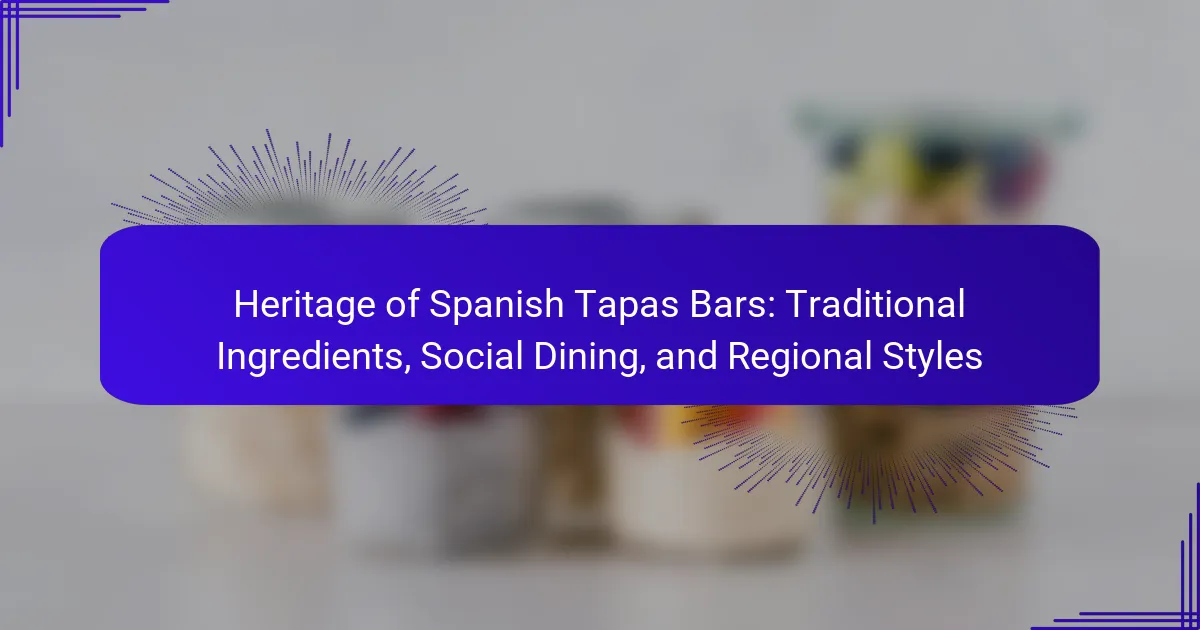
What is the heritage of Spanish tapas bars?
The heritage of Spanish tapas bars is deeply rooted in the country’s culinary and social traditions. Tapas originated in Spain as small plates of food served with drinks. This practice dates back to the 13th century, with references in historical texts. The term “tapa” means “cover” in Spanish, as these small dishes were initially used to cover drinks. Over time, tapas evolved into a diverse range of dishes. They reflect regional ingredients and culinary techniques across Spain. The social aspect of tapas dining encourages sharing and conversation. This communal dining experience is integral to Spanish culture. Today, tapas bars are a prominent feature in Spanish cities and towns, showcasing local flavors and culinary creativity.
How did Spanish tapas bars originate?
Spanish tapas bars originated from the practice of serving small plates of food alongside drinks. This tradition began in Spain to encourage social interaction among patrons. The word “tapa” means “lid” or “cover,” referring to how food was initially used to cover drinks. Historical evidence suggests that this practice dates back to the 13th century. It was common for taverns to offer small snacks to keep customers drinking longer. Over time, these small dishes evolved into a diverse culinary tradition. Today, tapas bars serve a variety of foods, reflecting regional ingredients and flavors. This evolution highlights the cultural significance of communal dining in Spain.
What historical events influenced the development of tapas bars?
The development of tapas bars was influenced by several historical events. The origins trace back to the Spanish monarchy in the 13th century. King Alfonso X is credited with promoting small dishes served with wine to encourage social interaction.
In the 19th century, the rise of taverns in Spain further popularized tapas. These establishments served as social hubs for locals. The Spanish Civil War (1936-1939) also impacted food culture. Rationing led to the creation of simple, affordable small plates.
Post-war recovery saw the resurgence of tapas bars. The 1980s brought international tourism, boosting the popularity of tapas globally. Today, tapas bars reflect Spain’s rich culinary heritage and social dining traditions.
Who were the key figures in the evolution of tapas culture?
The key figures in the evolution of tapas culture include various chefs, restaurateurs, and cultural influencers. Notably, chefs like José Andrés have popularized tapas internationally. His innovative approach has introduced traditional Spanish flavors to a global audience. Restaurateurs such as Juan Mari Arzak have also played a role in refining and elevating tapas cuisine. The influence of culinary schools in Spain has helped educate new generations about tapas. Furthermore, cultural movements in Spain have emphasized the social aspect of tapas dining. These figures and movements collectively shaped the rich tradition of tapas in Spain.
Why are tapas bars significant in Spanish culture?
Tapas bars are significant in Spanish culture because they embody social interaction and culinary diversity. They serve as communal spaces where people gather to share small dishes. This practice encourages conversation and fosters community ties. Historically, tapas originated as a way to accompany drinks, enhancing the dining experience. The variety of tapas reflects Spain’s regional ingredients and culinary traditions. Each region offers unique tapas, showcasing local flavors and customs. Tapas bars also promote a relaxed dining atmosphere, allowing patrons to enjoy food at their own pace. The cultural importance of tapas is recognized globally, influencing dining trends beyond Spain.
What role do tapas bars play in socializing and community?
Tapas bars serve as vital social spaces within communities. They encourage communal dining through shared plates. This sharing fosters interaction among patrons. Tapas bars often host local events, enhancing community engagement. They provide a relaxed atmosphere for friends and families to gather. The tradition of tapas promotes a culture of socializing over meals. Studies show that communal dining strengthens social bonds. In Spain, tapas bars are central to cultural identity and local customs.
How do tapas bars reflect regional identities in Spain?
Tapas bars reflect regional identities in Spain through their unique offerings and cultural practices. Each region showcases distinct ingredients that are locally sourced. For example, seafood tapas are prevalent in coastal areas like Galicia. In contrast, regions like Andalusia emphasize cured meats and cheeses. The style of dining also varies; some regions favor a more communal, social experience. This is evident in the bustling atmosphere of bars in cities like Barcelona. Additionally, traditional recipes often highlight historical influences, such as Moorish or Roman heritage. Tapas bars serve as a microcosm of regional diversity, embodying local customs and culinary traditions.
What are the traditional ingredients used in tapas?
Traditional ingredients used in tapas include olives, cheese, chorizo, and seafood. Olives are often marinated and served as a common appetizer. Cheese varieties like Manchego are popular in many tapas dishes. Chorizo, a Spanish sausage, adds a rich flavor to various preparations. Seafood such as anchovies and calamari is frequently featured in coastal regions. Vegetables like peppers and tomatoes are also commonly used. Bread is often served alongside tapas for dipping or as a base. These ingredients reflect Spain’s diverse culinary heritage and regional flavors.
What are the most common ingredients found in Spanish tapas?
The most common ingredients found in Spanish tapas include olives, cheese, and cured meats. Olives are often marinated and served as a flavorful snack. Cheese varieties such as Manchego are popular choices for pairing. Cured meats like chorizo and jamón ibérico are staples in many tapas dishes. Other common ingredients include seafood, such as anchovies and calamari. Vegetables like peppers and tomatoes frequently feature in tapas preparations. Bread is also essential, often served alongside various spreads. These ingredients reflect the rich culinary heritage of Spain and are integral to the tapas experience.
How do local ingredients vary across different regions of Spain?
Local ingredients in Spain vary significantly by region due to climate, geography, and cultural influences. For example, the Mediterranean coast features abundant seafood, such as anchovies and octopus. In contrast, the interior regions, like Castilla-La Mancha, are known for their rich meats and cheeses, such as manchego cheese. The Basque Country emphasizes fresh fish and unique vegetables, reflecting its coastal location and agricultural practices. Andalusia is famous for its olives and olive oil, a staple in many dishes. Each region’s culinary traditions are deeply rooted in its local produce, contributing to the diverse tapestry of Spanish cuisine. The differences in local ingredients highlight the uniqueness of each region’s food culture, influencing the tapas served in local bars.

What are the different styles of tapas dining?
There are several styles of tapas dining. The first style is “tapeo,” characterized by a casual, social atmosphere where diners move from bar to bar enjoying small plates. Another style is “raciones,” which offers larger portions meant for sharing among a group. “Pinchos” refers to tapas served on a skewer or with a toothpick, often found in northern Spain. “Montaditos” are small sandwiches that can also be considered a form of tapas. Lastly, “tapas de autor” are creative, gourmet interpretations by chefs. These styles reflect regional variations and cultural influences across Spain.
How is the dining experience structured in tapas bars?
The dining experience in tapas bars is structured around sharing small plates of food. Diners typically order multiple tapas to enjoy a variety of flavors. This encourages social interaction among guests, fostering a communal atmosphere. Tapas can be served cold or warm, offering diverse options. Customers often pair tapas with drinks, enhancing the experience. The setting is usually casual, allowing for relaxed dining. Many tapas bars have a vibrant ambiance, contributing to the overall enjoyment. This structure reflects the cultural significance of sharing meals in Spanish dining traditions.
What is the significance of sharing plates in tapas dining?
Sharing plates in tapas dining promotes social interaction and communal experience. This dining style encourages conversation and connection among participants. Tapas are typically served in small portions, allowing diners to sample various dishes. This variety enhances the overall dining experience. Sharing plates fosters a sense of togetherness and collaboration. It reflects the cultural values of Spanish hospitality. Historically, tapas originated as simple snacks, evolving into a communal dining tradition. This practice is integral to the enjoyment of food in Spanish culture.
How does the atmosphere of a tapas bar enhance the dining experience?
The atmosphere of a tapas bar significantly enhances the dining experience by fostering a social and communal environment. This setting encourages sharing and interaction among diners. The vibrant decor and lively ambiance create an inviting space for conversation. The aroma of diverse dishes stimulates the senses, making the meal more enjoyable. The informal dining style promotes relaxation and a laid-back approach to eating. Tapas bars often feature music, adding to the energetic vibe. This combination of elements makes the dining experience memorable and engaging. Research indicates that social dining can increase overall satisfaction and enjoyment of meals.
What are the various regional styles of tapas?
The various regional styles of tapas include Andalusian, Catalan, Basque, and Galician. Andalusian tapas often feature seafood and fried dishes, such as fried fish and calamari. Catalan tapas include dishes like pan con tomate and escalivada, showcasing fresh vegetables and bread. Basque tapas, known as pintxos, are typically served on skewers and include ingredients like chorizo and olives. Galician tapas often highlight seafood, with octopus and empanadas being popular choices. Each region’s style reflects local ingredients and culinary traditions, contributing to the diversity of tapas in Spain.
How do Andalusian tapas differ from those in Catalonia?
Andalusian tapas differ from those in Catalonia primarily in their ingredients and preparation styles. Andalusian tapas often feature seafood, such as fried fish and prawns, reflecting the region’s coastal geography. They also include cold dishes like salmorejo, a thick tomato soup, and various cured meats. In contrast, Catalan tapas emphasize ingredients like bread, cheese, and local vegetables. Dishes such as pa amb tomàquet, bread with tomato, are staples in Catalonia. The preparation methods also vary; Andalusian tapas are frequently fried, while Catalan tapas may be grilled or served fresh. These differences highlight the distinct culinary traditions shaped by each region’s history and geography.
What unique tapas dishes are associated with Basque cuisine?
Unique tapas dishes associated with Basque cuisine include pintxos, which are small snacks typically served on skewers. Another popular dish is txangurro, a spider crab preparation often served in its shell. Gambas al pil-pil, prawns sautéed in garlic and chili oil, are also a Basque favorite. Additionally, bacalao a la vizcaína features cod in a rich tomato sauce. These dishes reflect the region’s emphasis on fresh seafood and bold flavors. Basque cuisine is known for its high-quality ingredients and traditional cooking methods, making these tapas distinctive.

How do Spanish tapas bars influence modern dining trends?
Spanish tapas bars significantly influence modern dining trends by promoting shareable plates and social eating experiences. This dining style encourages communal dining, where guests sample various dishes. Tapas bars prioritize a relaxed atmosphere, fostering conversation and connection among diners. The trend of small plates has been adopted widely, allowing restaurants to showcase diverse flavors. Many contemporary menus now feature tapas-inspired offerings, reflecting global culinary influences. This shift aligns with the growing consumer preference for experiential dining. Research indicates that 70% of diners enjoy sharing food, highlighting the appeal of tapas-style meals. Overall, Spanish tapas bars have reshaped dining culture by emphasizing social interaction and diverse culinary experiences.
What are the contemporary adaptations of traditional tapas?
Contemporary adaptations of traditional tapas include innovative ingredient combinations and modern presentation styles. Chefs often incorporate global flavors, such as Asian or Middle Eastern spices, into classic dishes. For example, traditional patatas bravas may be served with a spicy sriracha aioli instead of the classic tomato sauce. Additionally, tapas are frequently presented in a more upscale manner, with artistic plating techniques.
Some establishments offer vegetarian or vegan versions of classic tapas, catering to changing dietary preferences. This includes items like chickpea fritters or zucchini croquettes. Furthermore, fusion tapas, which blend elements from different cuisines, have gained popularity. Examples include sushi-inspired tapas or tacos with Spanish fillings.
These adaptations reflect a broader trend of culinary creativity while maintaining the communal and social aspects of traditional tapas dining. As a result, contemporary tapas continue to evolve while honoring their heritage.
How have fusion cuisines incorporated tapas elements?
Fusion cuisines have incorporated tapas elements by blending traditional Spanish small plates with diverse culinary influences. This integration allows for creative flavor combinations and presentation styles. For example, Asian fusion tapas might include sushi rolls presented as bite-sized portions. Mediterranean fusion can feature hummus served alongside Spanish chorizo.
These adaptations often maintain the communal aspect of tapas dining. Sharing small plates encourages social interaction, a core principle of traditional tapas culture. Restaurants globally have embraced this format, offering tapas-inspired dishes that reflect local ingredients and techniques.
Research shows that tapas-style dining enhances the dining experience by promoting variety and exploration. A study published in the Journal of Culinary Science highlights how shared plates increase customer satisfaction and engagement.
What innovations are emerging in the tapas dining scene?
Innovations in the tapas dining scene include the incorporation of global flavors and modern cooking techniques. Chefs are experimenting with fusion tapas, blending traditional Spanish ingredients with influences from Asian and Latin cuisines. Additionally, there is a rise in plant-based tapas options, catering to the growing demand for vegetarian and vegan dishes. Interactive dining experiences are also becoming popular, where guests can participate in the preparation of their meals. Technology is playing a role as well, with restaurants using apps for ordering and sharing tapas. This evolution reflects changing consumer preferences and a desire for unique dining experiences. The trend towards sustainability is evident, with many establishments sourcing local and organic ingredients. This shift enhances the quality of dishes while supporting regional farmers.
What tips can enhance the experience of dining at a tapas bar?
To enhance the experience of dining at a tapas bar, consider sharing a variety of dishes with your group. This encourages social interaction and allows everyone to taste multiple flavors. Pairing tapas with appropriate wines or drinks elevates the overall experience. Ordering a mix of hot and cold tapas adds diversity to the meal. Engaging with the staff can provide insights into the best dishes and pairings available. Timing your orders to enjoy dishes as they are freshly prepared enhances flavor enjoyment. Exploring regional specialties can offer a deeper appreciation of the cuisine. Finally, taking your time to savor each dish fosters a relaxed dining atmosphere.
The main entity of the article is Spanish tapas bars, which are integral to the country’s culinary heritage and social culture. The article explores the origins of tapas, tracing their history back to the 13th century, and highlights the influence of historical events and key figures in shaping tapas culture. It details the significance of tapas bars in fostering communal dining and social interaction, as well as the regional variations in ingredients and styles across Spain. Additionally, the article discusses contemporary adaptations and innovations in tapas dining, emphasizing their impact on modern culinary trends and the dining experience.
